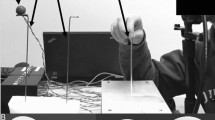Abstract.
Although, in principle, binocular cues provide veridical information about the three-dimensional shape of objects, our perception on the basis of these cues is distorted systematically. The consequences of these distortions may be less serious than they first appear, however, since in everyday life we rarely are required to judge the absolute shape, size or distance of objects. An important exception to this is in the control of prehension, where veridical information about an object to be grasped is required to plan the transport of the hand and to select the most appropriate grip. Here we investigate whether binocular cues provide accurate depth information for the control of prehension using disparity-defined, virtual objects and report that whilst binocular disparity can support prehensile movements, the kinematic indices, which reflect distance-reached and perceived size, show clear biases. These results suggest that accurate metric depth information for the control of prehension is not available from binocular cues in isolation.
Similar content being viewed by others
Author information
Authors and Affiliations
Additional information
Electronic Publication
Rights and permissions
About this article
Cite this article
Hibbard, P.B., Bradshaw, M.F. Reaching for virtual objects: binocular disparity and the control of prehension. Exp Brain Res 148, 196–201 (2003). https://doi.org/10.1007/s00221-002-1295-2
Received:
Accepted:
Issue Date:
DOI: https://doi.org/10.1007/s00221-002-1295-2




